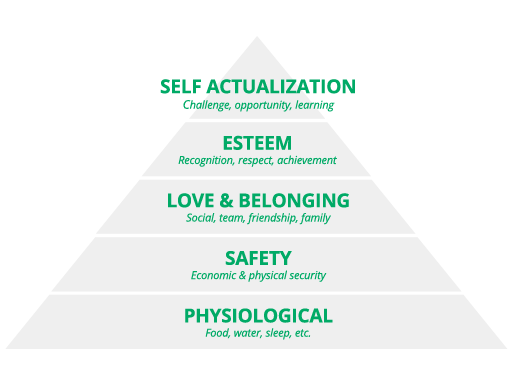10 Data-Driven Ways to Improve Employee Engagement
Employee engagement is one of the most popular yet misunderstood organizational topics. It’s a key competitive differentiator in the modern business landscape, and unsurprisingly, highly-engaged teams perform much better than their counterparts.
Think about your own team. How engaged are they?
Engaged employees work for more than just a paycheck. In this article, we’ll demystify employee engagement, delve into its advantages, share data-driven methods to improve employee engagement, and challenge you to examine your own practices.
What is employee engagement?
To start with, what does employee engagement mean? Employee engagement is the emotional commitment an employee has to their work, their team’s goals, and their company’s mission. Think about the most engaged coworker you know. How do they feel about their work?

In the context of Maslow’s Hierarchy of Needs, engagement falls right around Esteem and Love & Belonging, before Self-Actualization. In our professional lives, once our basic needs are taken care of (e.g. salary, safety, comfort, etc.), we focus on engagement. That manifests itself as wanting a connection to something bigger and feeling fulfilled professionally.
Why is employee engagement important?
Do you feel like you’ve heard more about Employee Engagement recently? It’s not just you. Discussion around the topic has grown immensely over the past 15 years, and for good reason. Just look at the number of Google searches around the topic during that time period:

When we compare teams, we find that the most engaged ones:
That’s not all, they also took fewer sick days, averted inventory shrinkage, had more satisfied customers, increased workplace safety, and improved product defect rates. A highly-engaged workforce benefits everyone in the company, from individual team members to leadership, as well as customers and other stakeholders.
Does your team still have work to do around employee engagement?
Ways to improve employee engagement
Employee engagement is a wide-reaching and complex subject. To get started, here are 10 data-driven ways to improve employee engagement, based on our recent Employee Engagement and Modern Workplace Report and other research:
1. Measure engagement
Highly engaged organizations are more likely than other organizations to measure engagement, and they are more likely to measure it more than once a year. - Bonusly’s State of Employee Engagement in 2019
You’re going to have a difficult time improving team engagement if you’re not measuring it! It’s important to collect data around employee engagement to understand where your team is at, understand what areas need to improve the most, and have a benchmark for future efforts.
If you’re not already doing so, use an employee engagement survey, and make sure that survey is both relevant and actionable. A great place to start is with Gallup’s Q12 survey, which measures employee engagement around 12 key elements in the employee experience.
Looking for tools to administer your survey? SurveyMonkey and Typeform are popular survey tools that are easy to use. Consider using quarterly or even monthly employee engagement surveys. You can also use tools like Officevibe and Culture Amp to help you keep tabs on a more regular basis.
After gathering responses (aim for 100% participation!) and reviewing the data, share the results with your teams. Discuss trends and ideas, then determine where you should put your resources based on results.
From a qualitative point of view, try out stay interviews…they’re like the opposite of exit interviews. Stay interviews can proactively help you understand why employees are sticking around and what makes them love their work.

2. Coach leadership
Employees who are supervised by Highly Engaged managers are 59% more likely to be engaged than those supervised by Actively Disengaged managers. - Gallup’s 2017 State of American Workplace
Early in my career, I interned for a baby product company in their car seat department and had a manager who loved talking with customers, researching competition, and making the best car seats in the industry. How do you think that impacted my own employee experience? Her engagement was contagious!
An organization’s leadership team and managers have a huge impact on employee engagement. It might not come as a surprise, but if your manager is engaged, you’re much more likely to be engaged yourself.
To improve engagement, start by coaching leadership and keeping them accountable. Think about who’s moved into leadership roles and how they influence your team. Listen to leaders, and equip them with the right education to be engaged and engage your team. At the same time, encourage them to attend onboarding sessions for new employees to set the right tone. And when analyzing engagement, consider the leadership level of respondents if possible.
A great book I’d recommend on people management is Radical Candor by Kim Scott. In it, she talks about the management philosophy of caring personally while challenging directly. It’s a great foundation for building strong leadership and trust within teams.

3. Onboard thoughtfully
Highly Engaged employees are 2.7x more likely to feel confident in their organization’s onboarding program than Actively Disengaged employees. - Bonusly’s 2019 Engagement and Modern Workplace Report
Onboarding is a key time to connect new employees with their work, team goals, and organizational mission. Looking back at Maslow’s Hierarchy of Needs, onboarding is an essential time for that middle step of Belonging. Think about your own onboarding experience and what stands out. Are your employees confident in your onboarding program?
At Corning, the manufacturers of the famous Gorilla Glass, the organization wanted to measure the difference between structured and unstructured orientation programs to understand the effects of onboarding on engagement and other factors. They found that new employees who attended a structured orientation program were 69% more likely to remain at the company up to three years.
When planning your own onboarding program, be sure to follow best practices like:
-
Introducing mentors that aren’t direct managers to guide new employees in their first 12 months
-
Involving executive leadership in onboarding presentations and events
-
Prioritizing relationship building with new employees’ coworkers
-
Creating smooth transitions from onboarding to regular work cadence
Need more guidance? Read our ultimate checklist for candidate interviews and employee onboarding.

4. Prioritize wellness
62% of Highly Engaged employees feel their work positively affects their physical health compared to 22% of Actively Disengaged employees. - Gallup’s Management Journal Employee Engagement Index Survey
Actively Disengaged employees are 2.6x more likely to often feel anxious at work compared to Highly Engaged employees. - Bonusly’s 2019 Engagement and Modern Workplace Report
When we talk about employee wellness that includes both physical and mental wellness. Often overlooked, wellness is a powerful factor in employee engagement. Our basic needs, from rest to nutrition to stability need to be met before we can even think about higher level needs. Do your employees feel healthy and balanced?
When it comes to physical health, is your company encouraging healthy living? Do your employees get enough sleep each night? Are they eating healthy inside and outside of work? Are they comfortable in the office?
As for mental health, do your company culture and benefits work together to create a welcoming and supportive environment for employees built on trust? Do you have a psychologically safe workplace? Do you offer a flexible work schedule? Do employees have work-life balance? Can employees talk openly about leaving for appointments with expectation of privacy?
How does wellness affect your own team’s engagement?

5. Focus on feedback
Highly Engaged employees are 3.1x more likely to say that their organization takes their feedback seriously than Actively Disengaged employees. - Bonusly’s 2019 Engagement and Modern Workplace Report
Highly Engaged employees are 3.3x more likely to feel like they receive adequate feedback for their role and contributions than Actively Disengaged employees. - Bonusly’s 2019 Engagement and Modern Workplace Report
You simply can’t have engagement without feedback. That means taking feedback from your team as well as giving feedback.
If you’re not already doing so, solicit feedback from your employees. Make it easy, offer anonymous methods, and test your feedback system to make make sure it’s easy and accessible. Once you receive feedback, make sure leadership acts on that feedback. Even if changes aren’t made, share why, at organization-wide meetings when appropriate, or privately.
When it comes to giving feedback, prioritize performance management. Consider a platform like Culture Amp or Small Improvements, and adopt weekly 1:1 meetings between managers and direct reports. If you already have a performance management program, revisit it and redesign it if necessary.

6. Recognize contributions
84% of Highly Engaged employees were recognized the last time they went above and beyond at work compared to only 25% of Actively Disengaged employees. - Bonusly’s 2019 Engagement and Modern Workplace Report
Highly Engaged employees are 2.1x more likely to work for a company with an employee recognition program* than Actively Disengaged employees. - Bonusly’s 2019 Engagement and Modern Workplace Report*
The most powerful factor that predicted employee engagement was recognition. Highly engaged organizations are far more likely to recognize employees for a job well done than their peers. When was the last time you were recognized for going above and beyond at work?
“We usually fill in a negative when we don’t hear anything” - Paul White, author of The 5 Languages of Appreciation in the Workplace
It’s important to give recognition; it’s more important that the receiver feels recognized. Keep in mind that your coworkers may (and likely do) prefer to be recognized differently than you do. Learn how your team prefers to be recognized, and bridge the appreciation gap to maximize your benefits.
Effective recognition follows best practices and prioritizes peer recognition. It’s timely, frequent, specific, visible, inclusive and values-based. When giving recognition, think about using the SBI model instead of just saying “good job” – that means describing the situation, the behavior that occurred, and the impact of that behavior.
Consider a recognition platform that meets your team where they’re at and makes recognition accessible. Bonusly is an employee recognition and rewards program that empowers teams to enrich company culture, available on the web, mobile apps, and integrations with chat platforms like Slack and HRIS systems like BambooHR and Namely.
Want to learn more about employee recognition and see examples of employee recognition in action? Check out our Guide to Modern Employee Recognition.

7. Foster innovation
Highly Engaged employees are 3x more likely to report working for an innovative organization than Actively Disengaged employees. - Bonusly’s 2019 Engagement and Modern Workplace Report
Do you work for an innovative organization?
One of my favorite innovation stories comes from Frito-Lay, where a team janitor, Richard Montanez, invented Flamin’ Hot Cheetos one day after experimenting with his family’s traditional spices and some of the factory’s rejected puffed-corn snacks. He was able to bring his idea to the senior leadership team and is now the Executive Vice President of Multicultural Sales and Community Activation.
Think about ways that your company can protect time to work on new, creative initiatives. At Bonusly, we reserve a week every quarter for our team to work on something outside of their normal day-to-day projects. We’re able to bring together teams from different departments to work on creative projects with support from the entire organization.
It’s also necessary to give your team autonomy. Laszlo Bock, former leader of People Ops at Google shares sage advice in his book, Work Rules:
“Give people slightly more trust, freedom, and authority than you are comfortable giving them. If you’re not nervous, you haven’t given them enough.”
Do your team’s managers let go of the reigns, or are they control freaks?
Finally, consider the 10 Dimensions of A Creative Climate by Professor Göran Ekvall. In it, he outlines a framework to better understand the level of creativity of teams, including the level of playfulness in an organization, the freedom to try different things, and support for new ideas. Work to create a culture that celebrates experimentation, welcomes failure, and reflects after projects.

8. Encourage professional development
91% of Highly Engaged employees are satisfied with their professional development opportunities compared to only 28% of Actively Disengaged employees. - Bonusly’s 2019 Engagement and Modern Workplace Report
Here’s a well-known but powerful exchange from Peter Baeklund:
A CFO asks CEO, “What happens if we invest in developing our people and then they leave us?”
CEO: “What happens if we don’t, and they stay?”
What do you offer for professional development?
Part of your job is to help your team achieve their professional goals. That can manifest itself in many different ways, from internal workshops to team lunch n’ learns to external education stipends. Employees focused on positive growth opportunities at their current role are more likely to stay engaged and less likely to look for opportunities.
Work with managers to implement career conversations in regular meetings with direct reports. Equip them with the skills to understand their team and help them plan for the future. If you take care of your employees’ goals, they’ll help the organization meet its goals.

9. Embrace transparency
Highly Engaged employees are 2.5x more likely to report working for a transparent organization than Actively Disengaged employees. - Bonusly’s 2019 Engagement and Modern Workplace Report
One of my favorite examples of company transparency were the weekly team lunches at an agency I worked at. We’d give updates across the three different offices via video chat, sharing news about everything from finances to new clients to hiring to project updates and even local news. Every week – with questions asked by everyone from interns to the CEO.
How transparent is your organization? A transparent work environment fosters trust, which leads to a sense of belonging and stability. It also gives employees the necessary contest to understand how their own role connects with the wider team and stakeholders.
Look for opportunities to make your own organization more transparent. Consider defaulting to transparency. By making transparency the modus operandi, you’ll always strive for transparency unless there’s a particularly compelling reason not to. It means that concealing is the exception.
Start by discussing important company metrics at organization-wide meetings. Be vulnerable and ask for questions. Work to break down barriers between teams by facilitating cross-team relationships through tools like Donut.

10. Focus on purpose
75% of millennials are willing to take a paycut to work for a values-driven company. - Cone Communications’ 2016 Millennial Employee Engagement Study
Highly Engaged employees are 2x more likely to feel like their job contributes to society than Actively Disengaged employees. - Bonusly’s 2019 Engagement and Modern Workplace Report
Extrinsic motivation is necessary to an extent. People need to have enough to take care of themselves and their family. However, thinking back to Maslow’s Hierarchy of needs, intrinsic motivation is necessary for our higher-level needs. Jobs need to provide meaning.
Scrutinize company mission and values. Then put them into action with the goal of your team embodying them every day. Your employees should know what the organization stands for and whether or not that aligns with their own values.
While you can’t give an employee a sense of purpose, you can help them discover it for themselves. Show employees the positive effects their work has on their colleagues, the company, and the world around them to help encourage a sense of purpose.
Zach Mercurio shared a powerful story of purpose from one of his recent workshops:
A group of supply chain mangers was recently asked, “Why does your job exist?”
A women in the back of the room raised her hand and said, “I found out why last month. I got diagnosed with cancer and was in an MRI machine. I looked up and realized we distribute a widget in that model. I realized my job existed all this time to save my own life.”
Talk about an antidote to disengagement. The group was instantly more energized, creative and passionate. When people can see that their work matters to another person, they are more motivated.
How does your own work impact others both inside and outside the company?
One of my favorite discussions around purpose at work was with a manager at a local car wash. He shared how the power of purpose propelled the company into its position as one of the fastest-growing businesses in Colorado. He explained that it’s everyone’s responsibility at the car wash to use that one interaction a month with customers to make their day better but also make their community better. They know employees won’t stay around forever, so they focus on how they can train their team to meet their personal and professional goals while strengthening the local community.
Next steps
Is that it? Are those the only factors that affect employee engagement?
Of course not! But it’s a good starting point based on the research we have. Employee engagement isn’t going away anytime soon, and for good reason. Successful companies can’t ignore its impact, and modern workers expect to stay engaged.
This article was originally published on Bonusly.
